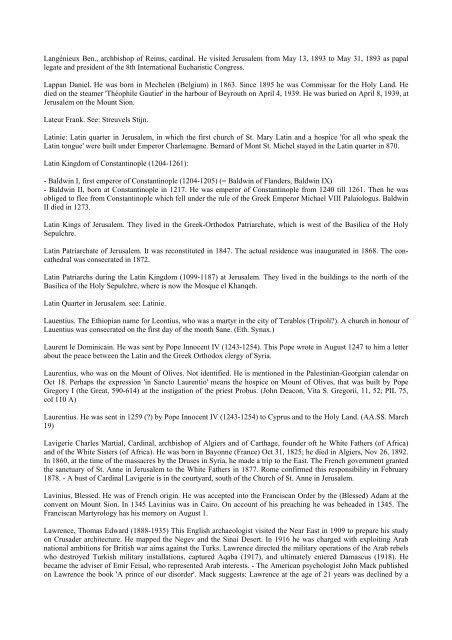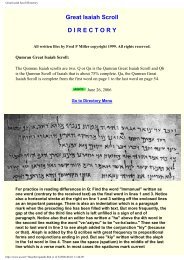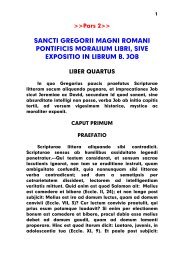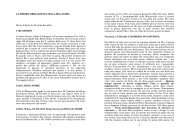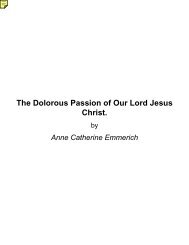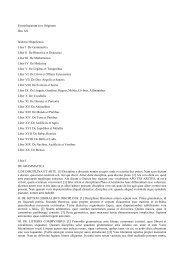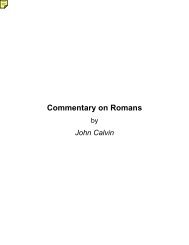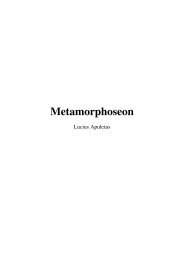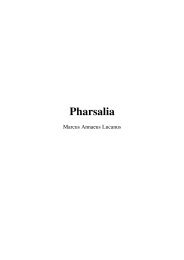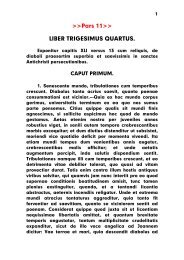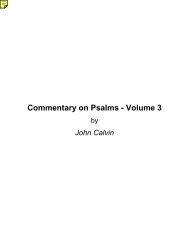List of Christians in the Holy Land - documentacatholicaomnia.eu
List of Christians in the Holy Land - documentacatholicaomnia.eu
List of Christians in the Holy Land - documentacatholicaomnia.eu
- No tags were found...
You also want an ePaper? Increase the reach of your titles
YUMPU automatically turns print PDFs into web optimized ePapers that Google loves.
Langéni<strong>eu</strong>x Ben., archbishop <strong>of</strong> Reims, card<strong>in</strong>al. He visited Jerusalem from May 13, 1893 to May 31, 1893 as papal<br />
legate and president <strong>of</strong> <strong>the</strong> 8th International Eucharistic Congress.<br />
Lappan Daniel. He was born <strong>in</strong> Mechelen (Belgium) <strong>in</strong> 1863. S<strong>in</strong>ce 1895 he was Commissar for <strong>the</strong> <strong>Holy</strong> <strong>Land</strong>. He<br />
died on <strong>the</strong> steamer 'Théophile Gautier' <strong>in</strong> <strong>the</strong> harbour <strong>of</strong> Beyrouth on April 4, 1939. He was buried on April 8, 1939, at<br />
Jerusalem on <strong>the</strong> Mount Sion.<br />
Lat<strong>eu</strong>r Frank. See: Str<strong>eu</strong>vels Stijn.<br />
Lat<strong>in</strong>ie: Lat<strong>in</strong> quarter <strong>in</strong> Jerusalem, <strong>in</strong> which <strong>the</strong> first church <strong>of</strong> St. Mary Lat<strong>in</strong> and a hospice 'for all who speak <strong>the</strong><br />
Lat<strong>in</strong> tongue' were built under Emperor Charlemagne. Bernard <strong>of</strong> Mont St. Michel stayed <strong>in</strong> <strong>the</strong> Lat<strong>in</strong> quarter <strong>in</strong> 870.<br />
Lat<strong>in</strong> K<strong>in</strong>gdom <strong>of</strong> Constant<strong>in</strong>ople (1204-1261):<br />
- Baldw<strong>in</strong> I, first emperor <strong>of</strong> Constant<strong>in</strong>ople (1204-1205) (= Baldw<strong>in</strong> <strong>of</strong> Flanders, Baldw<strong>in</strong> IX)<br />
- Baldw<strong>in</strong> II, born at Constant<strong>in</strong>ople <strong>in</strong> 1217. He was emperor <strong>of</strong> Constant<strong>in</strong>ople from 1240 till 1261. Then he was<br />
obliged to flee from Constant<strong>in</strong>ople which fell under <strong>the</strong> rule <strong>of</strong> <strong>the</strong> Greek Emperor Michael VIII Palaiologus. Baldw<strong>in</strong><br />
II died <strong>in</strong> 1273.<br />
Lat<strong>in</strong> K<strong>in</strong>gs <strong>of</strong> Jerusalem. They lived <strong>in</strong> <strong>the</strong> Greek-Orthodox Patriarchate, which is west <strong>of</strong> <strong>the</strong> Basilica <strong>of</strong> <strong>the</strong> <strong>Holy</strong><br />
Sepulchre.<br />
Lat<strong>in</strong> Patriarchate <strong>of</strong> Jerusalem. It was reconstituted <strong>in</strong> 1847. The actual residence was <strong>in</strong>augurated <strong>in</strong> 1868. The conca<strong>the</strong>dral<br />
was consecrated <strong>in</strong> 1872.<br />
Lat<strong>in</strong> Patriarchs dur<strong>in</strong>g <strong>the</strong> Lat<strong>in</strong> K<strong>in</strong>gdom (1099-1187) at Jerusalem. They lived <strong>in</strong> <strong>the</strong> build<strong>in</strong>gs to <strong>the</strong> north <strong>of</strong> <strong>the</strong><br />
Basilica <strong>of</strong> <strong>the</strong> <strong>Holy</strong> Sepulchre, where is now <strong>the</strong> Mosque el Khanqeh.<br />
Lat<strong>in</strong> Quarter <strong>in</strong> Jerusalem. see: Lat<strong>in</strong>ie.<br />
Lauentius. The Ethiopian name for Leontius, who was a martyr <strong>in</strong> <strong>the</strong> city <strong>of</strong> Terablos (Tripoli). A church <strong>in</strong> honour <strong>of</strong><br />
Lauentius was consecrated on <strong>the</strong> first day <strong>of</strong> <strong>the</strong> month Sane. (Eth. Synax.)<br />
Laurent le Dom<strong>in</strong>ica<strong>in</strong>. He was sent by Pope Innocent IV (1243-1254). This Pope wrote <strong>in</strong> August 1247 to him a letter<br />
about <strong>the</strong> peace between <strong>the</strong> Lat<strong>in</strong> and <strong>the</strong> Greek Orthodox clergy <strong>of</strong> Syria.<br />
Laurentius, who was on <strong>the</strong> Mount <strong>of</strong> Olives. Not identified. He is mentioned <strong>in</strong> <strong>the</strong> Palest<strong>in</strong>ian-Georgian calendar on<br />
Oct 18. Perhaps <strong>the</strong> expression '<strong>in</strong> Sancto Laurentio' means <strong>the</strong> hospice on Mount <strong>of</strong> Olives, that was built by Pope<br />
Gregory I (<strong>the</strong> Great, 590-614) at <strong>the</strong> <strong>in</strong>stigation <strong>of</strong> <strong>the</strong> priest Probus. (John Deacon, Vita S. Gregorii, 11, 52; PIL 75,<br />
col 110 A)<br />
Laurentius. He was sent <strong>in</strong> 1259 () by Pope Innocent IV (1243-1254) to Cyprus and to <strong>the</strong> <strong>Holy</strong> <strong>Land</strong>. (AA.SS. March<br />
19)<br />
Lavigerie Charles Martial, Card<strong>in</strong>al, archbishop <strong>of</strong> Algiers and <strong>of</strong> Carthage, founder <strong>of</strong>t he White Fa<strong>the</strong>rs (<strong>of</strong> Africa)<br />
and <strong>of</strong> <strong>the</strong> White Sisters (<strong>of</strong> Africa). He was born <strong>in</strong> Bayonne (France) Oct 31, 1825; he died <strong>in</strong> Algiers, Nov 26, 1892.<br />
In 1860, at <strong>the</strong> time <strong>of</strong> <strong>the</strong> massacres by <strong>the</strong> Druses <strong>in</strong> Syria, he made a trip to <strong>the</strong> East. The French government granted<br />
<strong>the</strong> sanctuary <strong>of</strong> St. Anne <strong>in</strong> Jerusalem to <strong>the</strong> White Fa<strong>the</strong>rs <strong>in</strong> 1877. Rome confirmed this responsibility <strong>in</strong> February<br />
1878. - A bust <strong>of</strong> Card<strong>in</strong>al Lavigerie is <strong>in</strong> <strong>the</strong> courtyard, south <strong>of</strong> <strong>the</strong> Church <strong>of</strong> St. Anne <strong>in</strong> Jerusalem.<br />
Lav<strong>in</strong>ius, Blessed. He was <strong>of</strong> French orig<strong>in</strong>. He was accepted <strong>in</strong>to <strong>the</strong> Franciscan Order by <strong>the</strong> (Blessed) Adam at <strong>the</strong><br />
convent on Mount Sion. In 1345 Lav<strong>in</strong>ius was <strong>in</strong> Cairo. On account <strong>of</strong> his preach<strong>in</strong>g he was beheaded <strong>in</strong> 1345. The<br />
Franciscan Martyrology has his memory on August 1.<br />
Lawrence, Thomas Edward (1888-1935) This English archaeologist visited <strong>the</strong> Near East <strong>in</strong> 1909 to prepare his study<br />
on Crusader architecture. He mapped <strong>the</strong> Negev and <strong>the</strong> S<strong>in</strong>ai Desert. In 1916 he was charged with exploit<strong>in</strong>g Arab<br />
national ambitions for British war aims aga<strong>in</strong>st <strong>the</strong> Turks. Lawrence directed <strong>the</strong> military operations <strong>of</strong> <strong>the</strong> Arab rebels<br />
who destroyed Turkish military <strong>in</strong>stallations, captured Aqaba (1917), and ultimately entered Damascus (1918). He<br />
became <strong>the</strong> adviser <strong>of</strong> Emir Feisal, who represented Arab <strong>in</strong>terests. - The American psychologist John Mack published<br />
on Lawrence <strong>the</strong> book 'A pr<strong>in</strong>ce <strong>of</strong> our disorder'. Mack suggests: Lawrence at <strong>the</strong> age <strong>of</strong> 21 years was decl<strong>in</strong>ed by a


